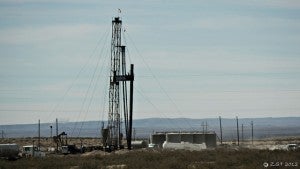By EDF Blogs
 By Jon Goldstein and Peter Zalzal
By Jon Goldstein and Peter Zalzal
The legal fight to defend the Bureau of Land Management’s (BLM) recent efforts to prevent oil and gas companies from wasting methane on public and tribal owned land continued yesterday.
EDF and a coalition of local, regional, tribal and national allies filed a brief opposing efforts by industry organizations and a handful states to block BLM’s protections before they even come into effect.
The states of New Mexico and California also sought to participate in the legal challenges, likewise stepping up to defend BLM’s common sense standards. Notably, New Mexico is the largest producer of oil from public lands in the U.S. and the second largest producer of natural gas.
In seeking to stay BLM’s protections, the industry associations have claimed the standards have no benefits – so blocking them won’t have any impacts on the communities they are designed to protect.
But BLM’s oil and gas waste standards are about ensuring that operators use common sense technologies to capture natural gas that would otherwise be wasted. That preserves a valuable natural resource and cleans up the air, all while putting additional royalty payments in the pockets of Western communities that can be used to fund schools, roads and important infrastructure.
For example, a recent analysis found that in 2013, oil and gas companies operating on public and tribal lands wasted more than $330 million worth of gas – more than $100 million of that from New Mexico alone. This translates to lost royalty revenues for local communities. One report estimates that without action to reduce this waste, taxpayers could lose out on more than $800 million in royalties over the next decade.
The challengers’ legal claims stand in stark contrast to the facts on the ground. Evidence of the broad-based benefits of BLM’s Waste Prevention Rule was readily apparent in yesterday’s court filings supporting the protections.. Current and former state and county officials and everyday Westerners alike let their voices be heard about the importance of common sense measures to preserve public resources and protect the environment.
For example, in their filing seeking to participate in the case, the states of New Mexico and California emphasized:
“Implementation of the Rule will benefit the States of California and New Mexico by generating more annual royalty revenue . . . . In addition, the Rule will benefit the health of the states’ citizens who are exposed to harmful air contaminants leaked, vented and flared from federally-managed oil and gas operations . . . . The People of California and New Mexico have a strong interest in preventing the waste of public resources, as well as in reducing the emission of harmful air pollutants that threaten the health of the states’ citizens, the integrity of their infrastructure, protection of their unique environments and ecosystems, and the continued viability of their economies.” ( Filing, pages 2 and 3)
And in their filing opposing the preliminary injunction, these states claimed:
“Because the Rule is likely to result in the stronger protection of federal lands and greater prevention of the waste of natural resources, which belong to the People, the public interest weighs strongly in favor of denying the injunction.” (Filing, page 16)
The benefits that New Mexico and California identified are broadly shared and were likewise reflected in declarations submitted by county officials and former state officials in support of the standards.
Current La Plata County Colorado Commissioner Gwen Lachelt identified both the problem of resource waste on public lands and the benefits for Western counties like hers in addressing it:
“The San Juan Basin, in which La Plata County is situated, has one of the highest rates of wasted gas and methane loss in the country, accounting for nearly 17% of U.S. methane losses.
“In addition to wasted methane, oil and gas sites in La Plata County and the San Juan Basin release dangerous pollutants such as benzene and ozone-forming pollutants that can lead to asthma attacks and worsen emphysema . . . . This air pollution continues to be a regional public health hazard, and has contributed to La Plata County receiving a low grade for poor ozone air quality from the American Lung Association…
“The Rule will benefit La Plata County by providing additional royalties that we can use to fund key County priorities—including infrastructure, roads, and education—while also helping to clean up the air in the San Juan Basin, which will have health benefits for our citizens.” (Filing, page 4 and 5)
Lachelt points out that unlike other leading oil and gas states like Colorado, New Mexico has no policies to reduce methane waste and other pollution from oil and gas wells, and that BLM’s efforts will help to provide uniformity across state lines.
Sandra Ely, a former Chief of the New Mexico Environment Department’s Air Quality Bureau likewise submitted a declaration describing the importance and benefits of the BLM standards. She particularly focused on the long-standing problem of resource loss in the San Juan Basin. The region made headlines in recent years when NASA scientists discovered a 200-square-mile methane cloud over the region – the largest methane cloud uncovered in the U.S. Subsequent studies determined that oil and gas emissions were the main contributor to the methane “hot spot.”
“I am aware of a recent study, focused on the San Juan Basin, which suggested that BLM’s proposed leak detection and repair requirements alone would result in anywhere from $1–$6 million dollars of additional revenue for New Mexico… Absent the Waste Prevention Rule, I am concerned that resource loss and poor air quality associated with oil and gas development will continue unabated in New Mexico” (Sandra Ely, Filing, page 7)
Western leaders have been vocal in their support for BLM’s sensible standards that take an important energy resource out of the air and deliver it responsibly to the American public. At public hearings that the BLM held across the west these rules were supported by more than 3 to 1 margins. More than 80 local officials across the West, including county commissions in La Plata, Park and San Miguel counties in Colorado and Bernalillo, Rio Arriba and San Miguel counties and the Santa Fe city council in New Mexico, all support the protections. And these rules enjoy broad bipartisan public support as well (more than 80 percent of Westerners in a recent poll).
Given this cross-cutting support and yesterday’s forceful legal filings, it’s no wonder that industry challengers in this case don’t even want the judge to hear the views of New Mexicans and Californians. Yesterday, they indicated that they would oppose these states’ efforts to protect the interests of their citizens by participating in the case. While this reflexive obstructionism isn’t surprising—industry petitioners filed their legal challenges within 40 minutes of the rule being finalized and tried to block the standards’ effectiveness shortly thereafter—it certainly reveals their very one-sided view of what is in the public’s interest.
The Wyoming Court is scheduled to hear oral argument in this case on January 6. We look forward to continuing to defend these standards that will clean the air and prevent waste.

Read more

 The need to plan for and design a more efficient, cleaner, and resilient electricity
The need to plan for and design a more efficient, cleaner, and resilient electricity  By
By 